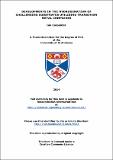Files in this item
Developments in the hydrogenation of challenging substrates utilising transition metal complexes
Item metadata
| dc.contributor.advisor | Clarke, Matt | |
| dc.contributor.author | Carpenter, Ian | |
| dc.coverage.spatial | 166 | en_US |
| dc.date.accessioned | 2015-04-22T14:17:30Z | |
| dc.date.available | 2015-04-22T14:17:30Z | |
| dc.date.issued | 2015 | |
| dc.identifier | uk.bl.ethos.644839 | |
| dc.identifier.uri | https://hdl.handle.net/10023/6533 | |
| dc.description.abstract | This thesis describes the developments of new protocols for the hydrogenation of challenging substrates. Three specific substrates were highlighted for study after an initial review of the literature; benzofurans, esters and bulky ketones. Chapter 1 details a review of the hydrogenation of challenging unsaturated substrates, highlighting areas where development is still required. Chapter 2 describes studies on the hydrogenation of 2,3-benzofuran. While a benzofuran hydrogenation catalysts was optimised, severe conditions were required to facilitate the reaction, and not found to be applicable for more elaborate substrates. We therefore considered an alternative process of enantioselective hydrogenation of benzofuranyl ketones followed by heterogeneous hydrogenation. A good process for transfer hydrogenation of a range of these hitherto unstudied substrates was developed along with greater understanding. The hydrogenation of esters is another challenge in the catalytic reduction field, so was also selected for study, with the results described in Chapter 3. After screening a range of catalysts of types [RuCl₂ (diphosphine)(diamine)] and [RuCl₂ (PNX)(DMSO)], good catalysts were identified. Successful hydrogenation of a range of esters, under mild conditions was achieved using [RuCl₂ (1,3-bisdiphenylphosphinepropane)(2-aminomethylpyridine)] using high concentrations of base co-catalyst. [RuCl₂ ((2-(diphenylphosphanylbenzyl)ethane-1,2-diamine)(DMSO)] combined with 15-25 mol% of a basic co-catalyst have been shown to be active at near ambient conditions in the hydrogenation of aromatic esters. Chapter 4 related to studies where the activity of Ru, Ir and Rh complexes of the same tridentate ligand were tested in the hydrogenation of ketones that would be regarded as sluggish substrates. Highly active and selective catalysts for the hydrogenation of bulky acetophenone derivatives were found using iridium complexes of PNX ligands (formed in situ). The highest selectivity was obtained with acetophenone substrates containing iso-propyl and cyclohexyl substituents, or medicinally important piperdinyl groups. In the best cases over 90% e.e. was observed with high conversions and with only 0.1 mol% of catalyst. | en_US |
| dc.language.iso | en | en_US |
| dc.publisher | University of St Andrews | |
| dc.rights | Creative Commons Attribution-NonCommercial-NoDerivatives 4.0 International | |
| dc.rights.uri | http://creativecommons.org/licenses/by-nc-nd/4.0/ | |
| dc.subject | Hydrogenation | en_US |
| dc.subject | Esters | en_US |
| dc.subject | Ketones | en_US |
| dc.subject | Benzofurans | en_US |
| dc.subject.lcc | QD281.H8C2 | |
| dc.subject.lcsh | Hydrogenation | en_US |
| dc.subject.lcsh | Transition metal complexes | en_US |
| dc.subject.lcsh | Esters | en_US |
| dc.subject.lcsh | Ketones | en_US |
| dc.title | Developments in the hydrogenation of challenging substrates utilising transition metal complexes | en_US |
| dc.type | Thesis | en_US |
| dc.contributor.sponsor | Engineering and Physical Sciences Research Council (EPSRC) | en_US |
| dc.type.qualificationlevel | Doctoral | en_US |
| dc.type.qualificationname | PhD Doctor of Philosophy | en_US |
| dc.publisher.institution | The University of St Andrews | en_US |
This item appears in the following Collection(s)
Except where otherwise noted within the work, this item's licence for re-use is described as Creative Commons Attribution-NonCommercial-NoDerivatives 4.0 International
Items in the St Andrews Research Repository are protected by copyright, with all rights reserved, unless otherwise indicated.


